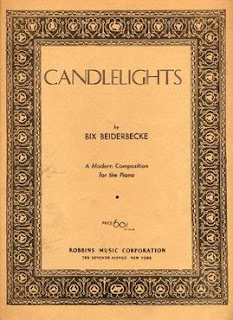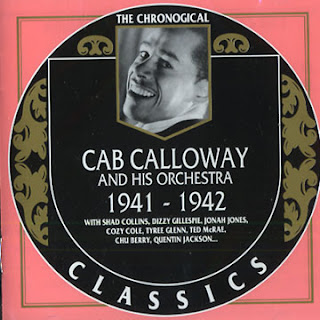Jess Stacy - Lee Wiley - J.Stacy and friends
Jess Stacy was a swing era pianist best known for his association with Benny Goodman. This 1980 compilation includes solo, duo, and trio recordings made between 1938 and 1944 and the sparse settings really highlight his unique approach to jazz piano. Playing with Goodman, he was primarily an accompanist, but at Carnegie Hall in 1938, he wowed everyone with an impromptu solo on "Sing Sing Sing".
The wonderful third session features some wonderful surprises, including guest tenor saxophonist Bud Freeman (1906-1991) joining Stacy on "(I got a woman crazy for me)She's Funny That Way". Freeman is a wonderful tenor saxophonist who plays and sounds just like Lester Young while maintaining the heavy vibrato of Coleman Hawkins. He plays simply here and the interaction between him and Stacy is obvious, with the pianist really digging in after Freeman's solo. The other three tracks are solo piano pieces including a grand version of "You're Driving Me Crazy" with a highly embellished melody that resembles a theme and variation approach. His solo is simple with a focus on short riffs punctuated by changes in the left hand.
The next two tracks from July 10, 1940 are trio with Stacy joined by his then-wife Lee Wiley on vocals and Muggsy Spanier on trumpet. I associate Spanier as being an extroverted player, but in this situation he is understated and plays simple lines. Giddins classifies Wiley as singing Ethel Waters-style, but I feel as if Wiley's vibrato is not as pronounced. It is in fact well placed and reminiscent of a blues wail. Her singing is also informed by the blues (and Billie Holiday), and she even gets a short wordless vocal solo on "Down to Steamboat Tennessee", co-written by Stacy and Wiley. There is perhaps no vocal accompanist like Stacy as he offers some nice rambly-lines, arpeggiated chords, and the piano's tenor voice behind Wiley. It sounds absolutely quirky and a delight to listen to.
If there ever was an underrated piano player it would have to be Stacy. During an era when pianists were busy using all ten of their fingers at all times, wowing audiences with technical facility, Stacy was by contrast understated. His playing is fundamentally based in stride, but his improvisations are more texture-based and based heavily in the blues. Far from being a virtuoso, he is instead more interested in varying his stride patterns, so that his left hand will play chords, unusual pads in the middle register, or even long lines that begin in the low register and end up towards the middle, He has a light touch and he values space unlike any other pianist of the era save Count Basie. Part of the reason he leaves so much space is because he tends to improvise like a horn player or a vocalist, playing short melodic phrases and leaving space to bring out his left hand. When he plays octaves in the right hand (which is often and likely a nod to an early influence Earl Hines), he often ends phrases with a short tremolo, resembling a singer's vibrato.
With bebop, the right hand took over as the main voice, but with Stacy his statement is derived not just from the lines in his right hand but also the left hand and both hands. Allowing his lines to breathe in his right hand, enables him to accentuate changes in his left hand, sometimes changing the chordal texture or bringing out the tenor voice in his left hand---the top note of his left hand voicing with the bass note on the bottom. At times, he'll only play the tenor voice and leave out the bass. Listening to Stacy, it sometimes feels like he is orchestrating a solo. He treats the range of the piano as one instrument.
"Ramblin'" is the lone song from the first session on April 30, 1938. In his liner notes, Gary Giddins says that Stacy plays three choruses, but I hear the same eight bars repeated. They are based on the changes of the first A section of "I can't believe that you're in love with me" and he revisits this progression later on this record. Despite the repetitive form, he maintains interest on this solo performance by changing the texture with dramatic pauses for single note lines, some rhythmic displacement, rubato, or letting his chords ring out. At some points, he'll just sit on some chords for longer than he's supposed to thus elongating the form---similar to country blues guitarists---and then make up for the lost bars later! I guess that's why he titled it "Ramblin'"! Overall this piece sounds like a mini-concerto and there is a some classical influence to the way he improvises.
The second session from January 18, 1939 also features Stacy playing solo on three pieces. Two are originals and both contain the strain from "I can't believe that you're in love with me". He seems to use forms beyond the normal ones on these tunes, but the performances are highly informed by the blues. The other piece is Bix Beiderbecke's "Candlelights". One of four solo piano compositions that he wrote, somehow the composer never recorded this piece but did publish it. "In the Mist" is the only one he recorded and is a marvel of modern music with the indelible influence of the impressionists. "Candlelights" is lighter in tone but otherwise similar with parallel chords, triads, and a strong quasi-classical identity. Stacy previously recorded Beiderbecke's other two piano pieces from the November 18, 1935 session and must have felt a kinship with the cornetist that may provide some insight into Stacy's approach to jazz piano.
 |
| CD Artwork |
"The Sellout" from the same session is a tongue in cheek reference to the ongoing boogie woogie revival. He sticks to stride, but seems to quote boogie woogie devices every now and then (bass lines, repeated chords, etc.). A normally quiet and thoughtful player, his stomping foot can be heard here. On this song and others, he has a humorous tendency to play false ending. He mprovisees all the way until the last bar of the chorus, ending with the low root and giving one the impression that he's finished, but then he comes right back with a new chorus.
"Ec-Stacy" is a slow blues, but he lets his chords ring out as if he were accompanied by bass and drums. He leaves so much space as if to sound like he's playing rubato or out of time, but he is in fact keeping time. There's something about that invisible metronome or internal time that really comes out on this performance. He does play stride but only for a few bars in the middle of the performance. Perhaps the most unique performance on the record.
 |
| Lee Wiley and Jess Stacy, 1943 |
The final six songs are from an unissued duo session with drummer Gordon "Specs" Powell from November 25, 1944. Now with drums keeping time behind him, Stacy does not vary the texture that much, but his performances are equally charming. He seems to enjoy himself on these sides with a sampling of standards ("After You've Gone", "Old Fashioned Love", and "I Ain't Got Nobody") and originals ("Blue Fives", "Ridin' Easy", and "Song of the Wanderer"). "After You've Gone" (which includes a little bit of his favorite strain from "I can't believe...") is a good example of his textural style with the emphasis alternatively on his right hand, his left, and both hands! It's really the only way to understand Stacy's approach. Recent modern pianist like Brad Mehldau and Fred Hersch have included these elements, but it is a device rather than a part of their sound: on every performance, Stacy conceives his music in this way.
I have a feeling that Jess Stacy is a kind of contrarian. Perhaps he knew that he wasn't as dazzling as Art Tatum or as exquisite as Teddy Wilson, so he carved out a role as a type of anti-hero jazz pianist. Taking cues from Beiderbecke and the blues, he crafted a highly personal approach that ends up sounding modern.
"Blue Fives" from the last session really brings out his unique individualism where he combines the language of barrelhouse piano players, the bouncy swing feel of early jazz musicians, all played with the touch of a lounge piano player. He sounds less abstract on this session but no less modern and improvises in the same manner.
At the heart of his playing is the blues. Five of his seven originals are twelve-bar blues and it shapes his phrasing, his lines, and the mood. He so frequently inserts the chromatically-descending blues cadence common to every blues song that it is practically a motif in his playing.
He reminds me of a Swing Era-Ahmad Jamal, who displayed similar qualities in his early trio with Israel Crosby and Vernell Fournier. Unfortunately his sound wasn't neatly packaged as Jamal's who combined his approach with a trio who understand their roles in the group. Jess Stacy really sounds like a pianist born decades too early, but he was too modern for the mainstream and too square for the avant-gardists.






Comments
Post a Comment